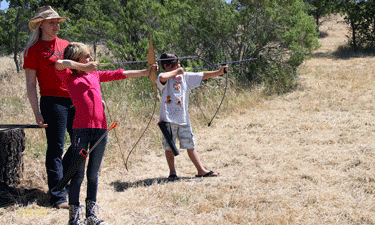 For years, archery had been overshadowed in the park and rec world. More popular team sports like basketball, baseball and soccer took the limelight, and at many agencies, bows, arrows and targets collected dust, forgotten in the back corner of an equipment cage, perhaps brought out a few times a year for day-camp activities.
For years, archery had been overshadowed in the park and rec world. More popular team sports like basketball, baseball and soccer took the limelight, and at many agencies, bows, arrows and targets collected dust, forgotten in the back corner of an equipment cage, perhaps brought out a few times a year for day-camp activities.
But then came The Hunger Games, a book series so overwhelmingly popular that it outsold Harry Potter on Amazon. In the series, protagonist Katniss Everdeen uses her hunting and archery skills to survive an annual competition in which children are forced to fight to the death in a futuristic dystopian society. The books were followed by a blockbuster movie series starting in 2012, and Hollywood quickly churned out The Avengers, Snow White and the Huntsman, Brave and Arrow over the next few months, all of which featured skilled archers and gave a new “cool” factor to the sport. Park and rec programmers nationwide quickly felt the impact of the books and films as members of their communities began clamoring for archery lessons. Interestingly, a significant proportion of those intrigued by the sport were young women and girls, driven by the take-charge examples set by heroines Katniss of The Hunger Games and Merida of Brave.
“There has clearly been heightened interest, particularly among women and girls,” says Judith Kieffer, executive director of the Los Angeles Parks Foundation, regarding archery participation levels at the city’s new Easton Rancho Park Archery Range. “Everyone in the volunteer cadre over there says how many more women and girls come to the range as beginners.”
USA Archery, the sport’s Olympic-sanctioning body, saw youth memberships increase 104 percent between 2011 and 2013 and then another 121 percent from 2013 to 2014. Memberships purchased by females similarly shot up by 105 percent in 2014. According to the Sports and Fitness Industry Association, 6,180,000 Americans tried their hand at archery in 2008, but by 2013, that number had climbed to 7,647,000 participants. Factoring in a concurrent increase in bowhunting participation, other research bodies reported even higher numbers. Regardless of the information source, it’s clear park and recreation agencies have an opportunity on their hands.
“Virginia Beach Parks and Recreation’s archery program predates the Hunger Games franchise,” shared Michael Kalvort, CPRE, director of Virginia Beach Parks and Recreation, on the NRPA Connect 10 Million Kids Outdoors forum. “However, once the books and movies gained popularity, we started including references in our program write-ups…We created a nontraditional, fun archery competition called ‘The Archery Games,’ inspired by The Hunger Games. The popularity and participation numbers for all archery classes has remained consistent since its inception with most classes reaching their maximums. We believe the popularity of the franchise has had a positive effect on awareness of archery as a sport and therefore our participation numbers. Anecdotally, many participants reference the series in our classes as reasons for their interest in the sport.” Kalvort also noted that his agency offers free archery demo days, which “usually attract more than 100 people per session and serve as a marketing tool for upcoming classes.”
At Starvation State Park in northeastern Utah, the new 3D Archery Range has attracted significant interest from park visitors and may be a contributing factor in the park’s recent revenue increases. Visitors are invited to use the course under their general entrance fee, and it offers nine stations, child and adult bows and arrows, 20 3D animal targets and three regular archery targets spread across a high desert pinyon-juniper landscape. Since the range opened last June, participation levels have been “better than we thought we would have,” says Alan Spencer, the park’s assistant manager. When asked if the recent archery-focused movies might have had an impact on the success of the range, Spencer noted, “It very well could have an influence, especially in some of the younger users. We did see more young female shooters than I thought we would have. My own daughters have certainly shown more interest from watching the movie.”
In Missouri City, Texas, Interim Assistant Director of Parks and Recreation and father Shane Mize has also seen the influx of young women taking up archery on his son’s shooting sports team. “I can attest as a parent in the club that the [number of] ladies in the archery classes has increased dramatically,” he says. “In fact, not only has it increased, but in our area of the world the large majority of girls doing archery are doing it with a long bow. The unique thing is the compound bow is easier to use, aim and is the preferred hunting option. But in shooting for purely sport, we are seeing most ladies using the long bow. So that movie has seemed to create a nonhunting faction of girls who are shooting the long bow for sport only, something that was near unheard of before those movies came out. Any girls in archery were there for hunts and all used the compound bow.”
Whether the upshot in archery participation levels will remain high after the excitement from the movies dies down remains to be seen, but the renaissance in this ancient sport is a positive development, to say the least. In addition to the benefits of archery like increased upper body strength, improved concentration and focus, enhanced coordination and other advantages, the sport also offers its athletes a boost of confidence and empowerment every time they hit their target.
Danielle Taylor is the Executive Editor of Parks & Recreation magazine.

